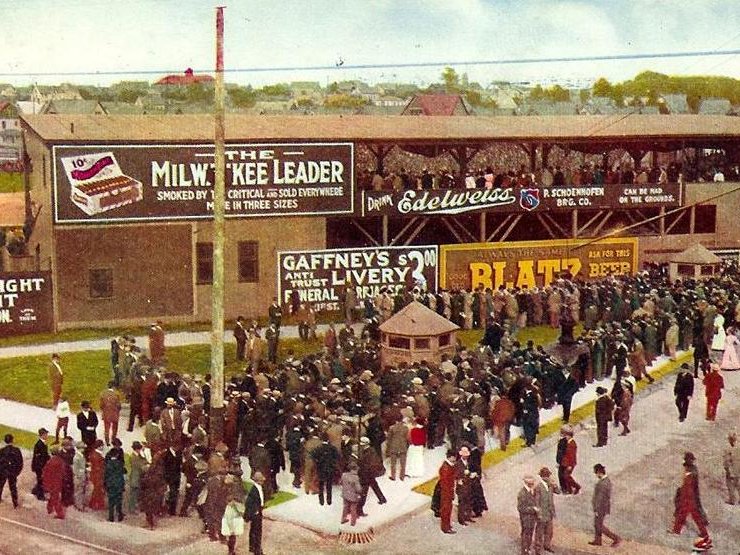You have visited the site of Milwaukee's most historic ballpark probably hundreds of times, and you probably never knew it.
No, I am not talking about the relatively recently-departed County Stadium, but rather its predecessor, gone without a trace for almost 60 years Borchert Field. Today, there is nothing to demarcate the former home of the American Association's Milwaukee Brewers other than a hard to find historical marker hundreds of yards away from where the actual ballpark was.
But then, a marker where Borchert Field stood would have been run over millions of times. Where a half-century of our city's baseball history took place is now Interstate 43 between Burleigh and Chambers Streets.
Borchert Field, known at the time colloquially as "The Orchard," was more than just a baseball park. It was also used in the early days of the NFL as the home stadium for the defunct Milwaukee Badgers from 1922-26, and then later the Green Bay Packers for part of the 1933 season. Boxing matches were held at the venerable old yard, as were track and field meets, fireworks exhibitions and even gymnastics competitions.
A temporary velodrome was constructed for cycling in 1936. International soccer matches were held in the summertime when the Brewers were on road trips in the 1950s.
In recent years the NHL has sanctioned one or two outdoor "Winter Classic" games at traditional baseball and football venues. Wintertime at Borchert Field this was commonplace.
Built in 1888 and simply named Athletic Park (the ballpark would not be named for Brewers owner Otto Borchert until after his death in 1927), the stadium was primarily for baseball, and several clubs called the park home. The Milwaukee Creams of the Western League opened the park up, but they would not last; nor would our lone entry in the Negro Leagues, the Milwaukee Bears of 1923.
But from 1902-1952, Milwaukee was in love with their minor league Brewers.
The stadium itself was nothing special and very much a product of its time. A single-decked angular horseshoe sandwiched within the confines of the neighborhood it inhabited, Borchert Field stood for more than 50 years as Milwaukee's cultural gathering place. Somewhat resembling a scaled-down version New York's famed Polo Grounds; home runs to the corners were quite easy, with only 268 feet to clear down each line. However, a poke to the power alleys would have to travel a Herculean 435 feet to earn a trip around the bases.
The stadium could charitably be called rickety. But it was all Milwaukee had. And for generations, it was our destination.
But the intimate atmosphere and quirky dimensions only tell a part of the story. In fact, that story is still evolving even today.
"I remember sitting in a George Webb in Wauwatosa in maybe 1984 or '85," Brooklyn, N.Y. resident Chance Michaels says today. "They had a picture on the wall of one of their old restaurants from the '40s. In that picture I could clearly see a placard on the wall that said 'George Webb predicts our Brewers win 12 games in a row.' I didn't realize there was anything before the Braves."
Michaels, a New York City native who spent his childhood in Southeastern Wisconsin, was hooked on baseball from that moment on. But who were these Brewers? Of course he knew of the American League Brewers, but the fact that there was baseball played in Milwaukee before the Braves arrived was an entirely foreign concept to the then 13-year old future off-Broadway producer.
In 2009, with the nagging desire to try to tell the exhaustive story of Milwaukee's first sporting cathedral, Michaels launched and developed BorchertField.com, what is described as "the only online museum dedicated to the Milwaukee Brewers of the American Association, 1902-1952, their ballpark, and the events it hosted."
"What we have tried to do is take advantage of the possibilities the internet has to offer for sharing an interest that in previous years that might have gone completely unnoticed," Michaels continued.
Unquestionably, Borchert Field's most colorful character was Bill Veeck, the legendary eventual owner of the Chicago White Sox, who was known as the P.T. Barnum of baseball. Veeck owned the Brewers from 1941-45, winning three pennants during his five years here.
One of the most infamous stories about Veeck's tenure with the Brewers was the tale that he had a movable screen in the outfield that was wheeled out when the opposing team was up and moved away when the Brewers were at bat. As the fable goes, the visitors were unable to hit home runs over the contraption. Veeck's telling of the story said that he did this because there was no rule against it – until the very next day after the rest of the teams in the American Association complained.
Research suggests that this may be nothing more than urban legend and Veeck's own vivid imagination, but those that knew him were never shocked that he might try to pull a stunt like that.
One of Michaels' initial challenges was to find images from Borchert Field, demolished almost 20 years before he was born. Amateur photography was still in its infancy during the stadium's heyday, with the enormously popular Kodak Brownie 127 model not being introduced until 1952.
Undaunted, Michaels sought out whatever he could find from the archives of the Milwaukee Journal and Milwaukee Sentinel. (Impossible as it seems today, OnMilwaukee.com did not yet exist when Borchert Field was still standing.)
What he found was a rich tapestry that appeals not only to baseball fans, but to historians from all walks of Milwaukee life. Along the way he has been able to enlist collaborators who also share his passion for weaving narrative tapestries of a bygone era.
"It's not just my labor of love," Michaels says. "I've got some really great contributors who have allowed me to spread the breadth of our collective knowledge."
Among the writers that Michaels works with are lifelong Milwaukeeans Paul Tenpenny and Dennis Pajot, both of whom are active in the Milwaukee (Ken Keltner) Chapter of the Society for American Baseball Research (SABR).
The story of Borchert Field is one that is ever evolving. After all, more than a half-century of our sports history was destroyed long before anyone thought about trying to preserve any of it. After all, as Michaels puts it, "because the interstate is sunk below where the ground was, they literally scooped the ballpark off the face of the earth."
But for Michaels, while the images of physical structure of Borchert Field are worth discovering, they are not what fuel his passion.
"We've done stories on the people that worked there," he concludes. "We've written about ticket takers and the organist. In some cases these were people who worked at the ballpark for decades. Those are the stories I love to tell."
Doug Russell has been covering Milwaukee and Wisconsin sports for over 20 years on radio, television, magazines, and now at OnMilwaukee.com.
Over the course of his career, the Edward R. Murrow Award winner and Emmy nominee has covered the Packers in Super Bowls XXXI, XXXII and XLV, traveled to Pasadena with the Badgers for Rose Bowls, been to the Final Four with Marquette, and saw first-hand the entire Brewers playoff runs in 2008 and 2011. Doug has also covered The Masters, several PGA Championships, MLB All-Star Games, and Kentucky Derbys; the Davis Cup, the U.S. Open, and the Sugar Bowl, along with NCAA football and basketball conference championships, and for that matter just about anything else that involves a field (or court, or rink) of play.
Doug was a sports reporter and host at WTMJ-AM radio from 1996-2000, before taking his radio skills to national syndication at Sporting News Radio from 2000-2007. From 2007-2011, he hosted his own morning radio sports show back here in Milwaukee, before returning to the national scene at Yahoo! Sports Radio last July. Doug's written work has also been featured in The Sporting News, Milwaukee Magazine, Inside Wisconsin Sports, and Brewers GameDay.
Doug and his wife, Erika, split their time between their residences in Pewaukee and Houston, TX.







